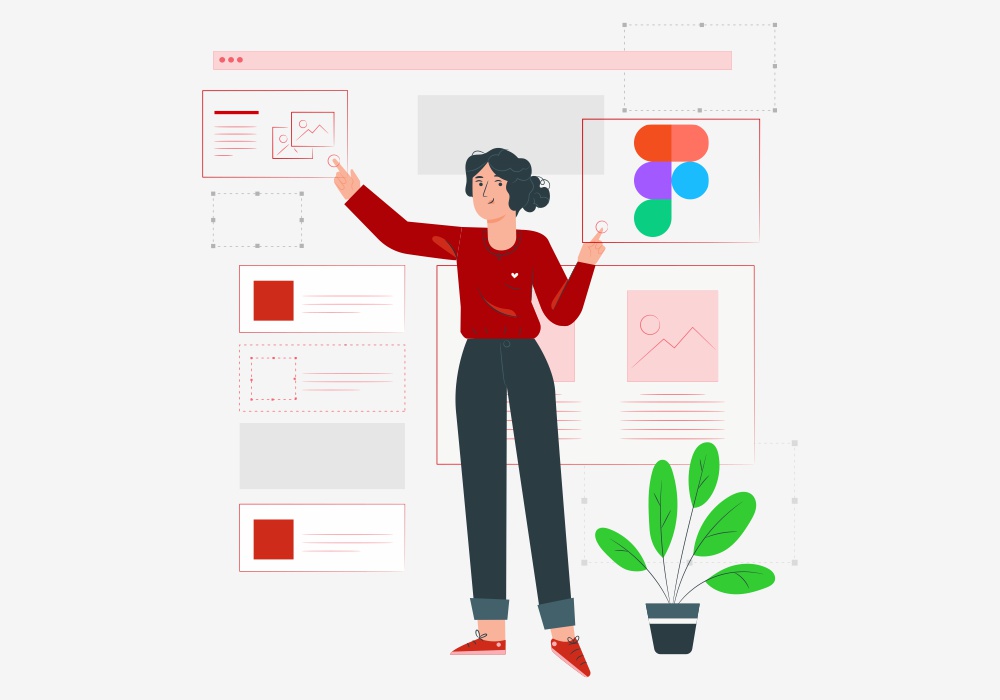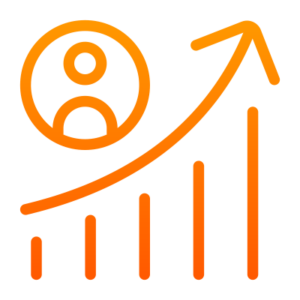Figma has become a cornerstone of modern design, fundamentally changing how creatives collaborate and bring ideas to life.
This cloud-based platform empowers designers with a versatile toolbox, encompassing UI/UX design, graphic design, prototyping, and more – all accessible from any web browser.
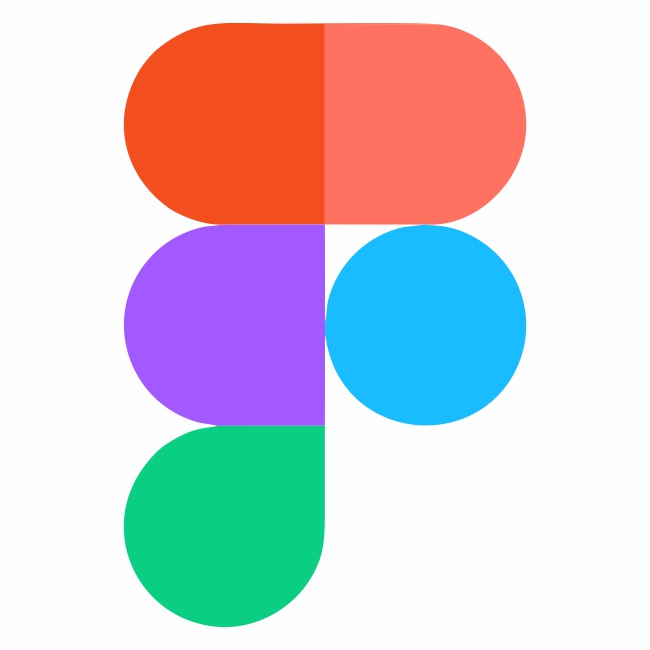
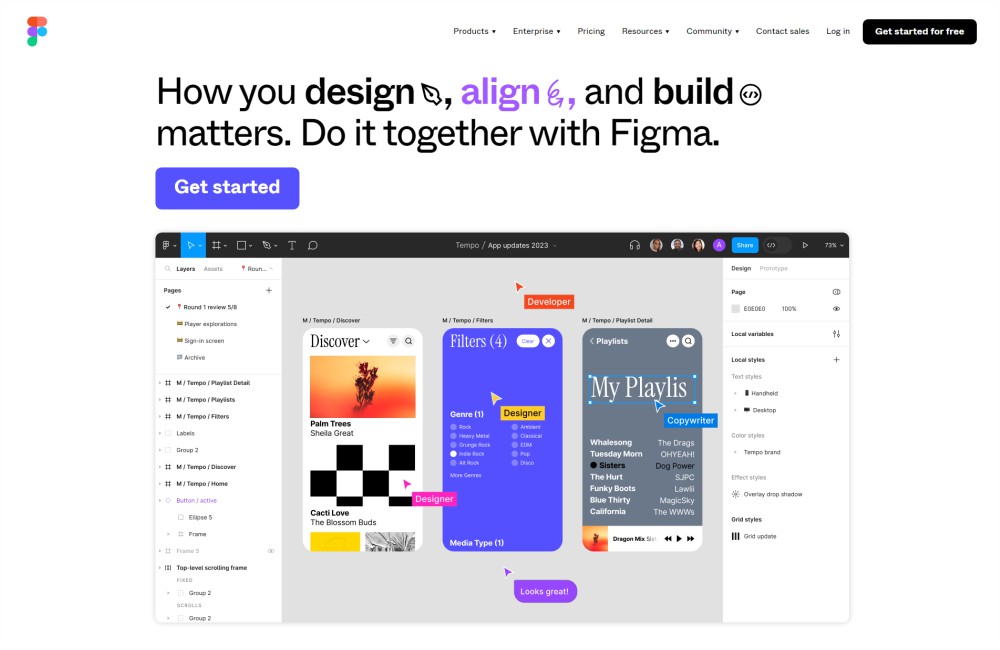
Figma is a vector graphics editor and prototyping tool primarily web-based, allowing designers to work collaboratively in real-time.
Since its launch in 2016, Figma has quickly become a favourite among designers for its user-friendly interface, powerful features, and ability to streamline the design workflow.
Unlike traditional design software that is often restricted to individual use, Figma’s cloud-based nature enables teams to collaborate on projects seamlessly, no matter where they are located.
Benefits of Figma
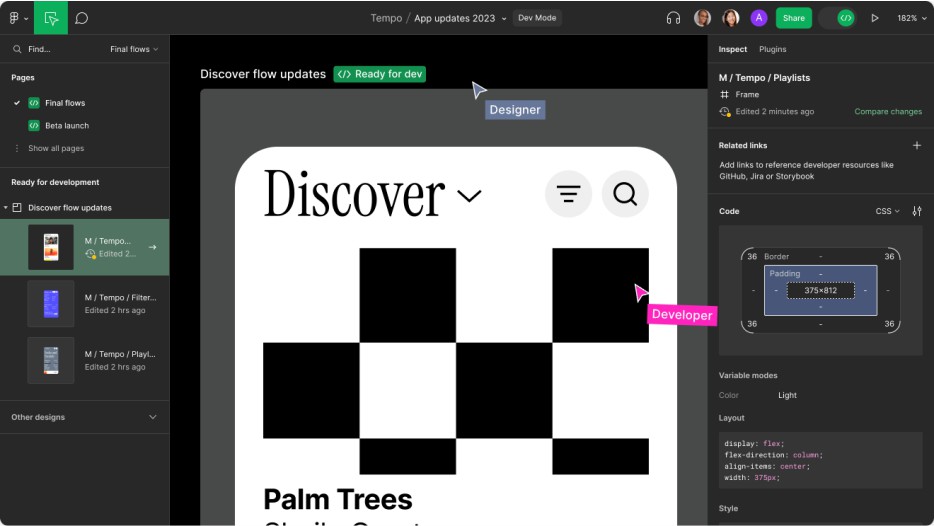

Real-time Collaboration
Figma’s standout feature is its collaborative capabilities.
Multiple users can work on the same project simultaneously, seeing each other’s changes in real time.
This fosters a more cohesive and efficient workflow, especially for remote teams.

Platform Independence
Being web-based, Figma can be accessed from any device with an internet connection, without powerful hardware.
This accessibility makes it an excellent option for designers who use different operating systems or do not have access to high-end computers.

Comprehensive Design Features
Figma offers a wide range of design features, including vector editing, prototyping, and code generation.
It supports the entire design process from ideation to delivery, making it a one-stop shop for digital designers.

Extensive Plugin Ecosystem
The Figma community has developed a vast array of plugins to extend the functionality of the tool.
These plugins can automate tasks, integrate with other tools, and add new features, further enhancing the design process.

Free Tier Available
Figma offers a generous free plan, making it accessible to freelancers, small teams, and those just starting in the design field.
This has contributed to its widespread adoption and community growth.
Pros and Cons of Figma
Pros
- Enables real-time collaboration across teams
- Cloud-based, ensuring platform independence and accessibility
- Intuitive user interface, suitable for beginners and professionals alike
- Robust community support and a plethora of plugins
- Streamlines the design process with comprehensive features
Cons
- Internet dependency means access issues in areas with poor connectivity
- Can be less responsive than desktop applications for complex projects
- The free version has limitations on team size and project history
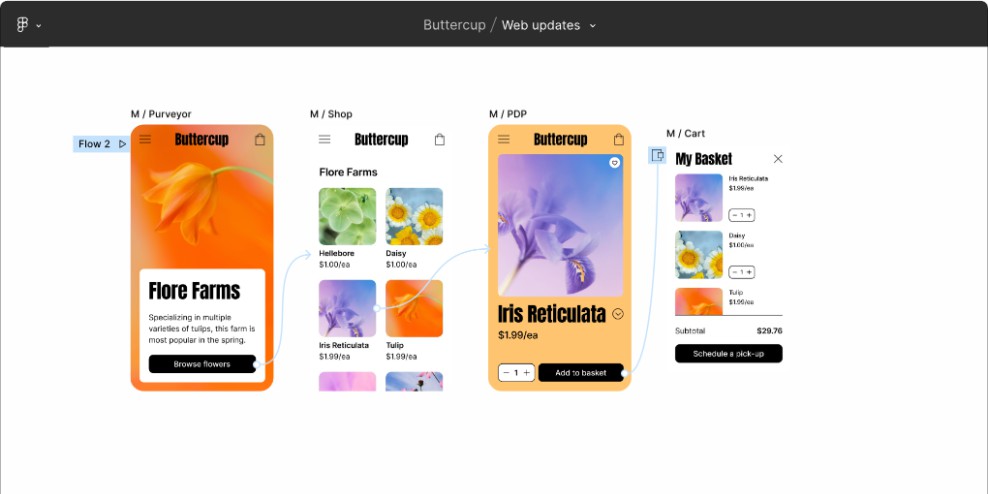
How to Use Figma
- Getting Started: To begin with Figma, create an account on their website. You can start with a free plan, which is ample for learning and small projects.
- Navigating the Interface: Once logged in, Figma will present you with a dashboard where you can create new files, access recent projects, and explore templates. The interface is divided into sections for file browsing, design creation, prototyping, and code inspection.
- Designing with Figma: Start a new project by creating a new file. Figma allows you to draw shapes, insert text, create symbols, and use layers, much like other vector graphics software. The tools are intuitive, with drag-and-drop functionality for ease of use.
- Collaboration: Share your project with team members by sending them a link or inviting them via email. You can then work on the project simultaneously, leave comments, and make real-time edits.
- Prototyping: Figma simplifies prototyping by allowing you to link design elements and create interactive flows. This is crucial for testing UI/UX designs and presenting ideas to stakeholders.
- Exporting Your Work: Once your design is complete, Figma provides various export options, including PNG, JPG, SVG, and PDF. You can also generate code snippets to help bridge the gap between design and development.
Figma Plugins
Extend Functionality and Boost Efficiency
Think of Figma plugins as superpowers for your design workflow.
These custom-built extensions seamlessly integrate with Figma, offering a vast array of functionalities to streamline your design process and enhance your creative toolkit.

Enhanced Design Tools
Elevate your design game with plugins that offer features like advanced prototyping, data visualization, and animation capabilities.
Generate interactive prototypes with ease, create compelling data charts, and bring your designs to life with smooth animations.

Streamlined Workflows
Simplify repetitive tasks and boost efficiency with automation plugins.
Generate consistent color palettes, manage design systems effortlessly, and streamline asset management, freeing up valuable time to focus on the creative aspects of design.

Collaboration Made Easy
Foster seamless collaboration within your design team with plugins that facilitate communication and feedback sharing.
Utilize plugins for real-time design handoffs, centralized design libraries, and streamlined version control.
Popular Figma Plugin Categories
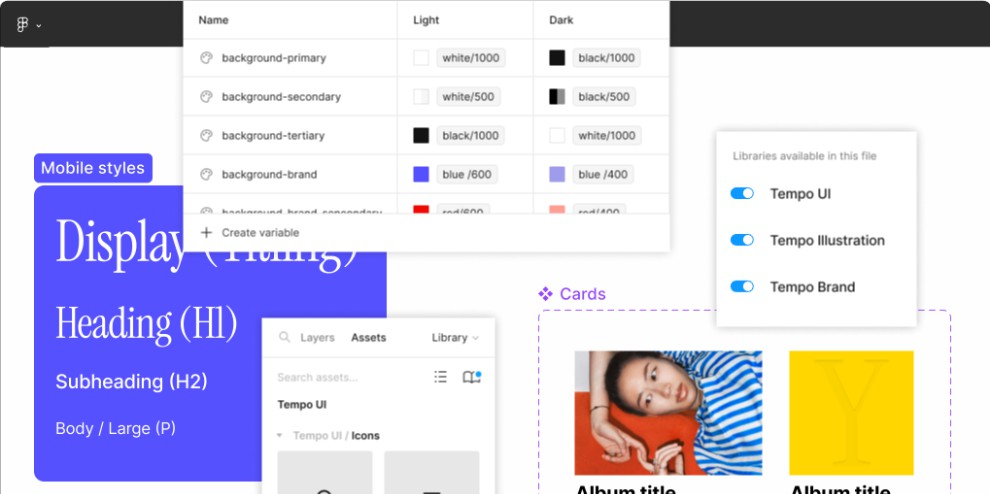

Prototyping
Generate interactive prototypes to showcase user flows and test design functionality. (e.g., ProtoPie, LottieFiles)

Design Systems
Manage and maintain design system components for consistent brand identity. (e.g., Anima, NxTH Level Design System)

Illustrations and Icons
Integrate high-quality illustrations and icon libraries directly into your designs. (e.g., Blush, The Noun Project)

Accessibility
Ensure your designs are inclusive for all users with accessibility-checking plugins. (e.g., Stark, a11y checker)
The Figma plugin library is a treasure trove of possibilities.
Explore the vast array of plugins available, considering factors like your specific design needs, team workflow, and budget.
Best Figma Plugins

Prototyping Powerhouses
- ProtoPie (Free & Paid Plans): Go beyond basic prototyping with features like micro-interactions, physics simulations, and complex branching logic. Breathe life into your designs and create ultra-realistic prototypes for user testing.
- LottieFiles (Free & Paid Plans): Effortlessly integrate smooth and lightweight Lottie animations directly into your Figma prototypes. This plugin allows you to import animations from After Effects or use LottieFiles’ vast animation library, adding a touch of dynamism to your designs.

Design System Dream Teams
- Anima (Free & Paid Plans): Streamline your design system workflow with features like automatic component creation, style guide generation, and easy library management. Ensure design consistency across all projects and empower your team with a centralized design system source.
- NxTH Level Design System (Free & Paid Plans): This plugin offers a suite of tools specifically designed for managing design systems within Figma. Organize your design tokens, manage variants, and generate code snippets for developers, fostering seamless collaboration between design and development teams.

Illustration and Icon Integration
- Blush (Free & Paid Plans): Spice up your designs with beautiful and customizable illustrations. Blush offers a vast library of vector illustrations across various styles, allowing you to find the perfect fit for your project. Plus, you can customize colors and elements to match your brand identity.
- The Noun Project (Free): Access a massive collection of free and high-quality icons directly within Figma. The Noun Project allows you to search for specific icons by keyword and easily integrate them into your designs, adding clarity and visual interest.

Accessibility Champions
Stark (Free & Paid Plans): Ensure your designs are inclusive for all users with Stark’s accessibility checker plugin. This plugin identifies potential accessibility issues related to color contrast, keyboard navigation, and more, empowering you to create designs that are usable by everyone.
a11y Checker (Free): Another valuable accessibility plugin, a11y Checker helps you identify and address accessibility concerns within Figma. This plugin analyzes your designs for color contrast issues, empty alt text for images, and other accessibility considerations.
Bonus Tip: Explore the Figma Community plugin library!
You’ll discover a treasure trove of free and paid plugins catering to various design needs.
From data visualization tools to content generation plugins, the Figma community offers a wealth of options to customize and enhance your design workflow.
The Difference Between Figma and Canva

Target Audience

Figma
Designed primarily for professional UI/UX designers and teams, Figma offers a comprehensive suite of tools that cater to detailed digital design work, including website and mobile app interfaces.
Its collaborative nature makes it ideal for design teams looking to work together in real time on complex projects.

Canva
Canva appeals to a broader audience, including non-designers, marketers, educators, and small business owners.
It simplifies the design process with ready-to-use templates and an intuitive drag-and-drop interface, making professional-looking designs accessible to everyone.
Core Features

Figma
- Vector Design Capabilities: Allows precise control over design elements, making it suitable for detailed UI/UX projects.
- Collaborative Design: Enables multiple users to work on the same project simultaneously, with real-time updates and commenting features.
- Prototyping and Animation: Offers advanced prototyping features, including interactive components and animations, to simulate how designs will function in the real world.
- Plugin Ecosystem: Supports a wide range of plugins, enhancing functionality and automating workflows.

Canva
- Template-Driven Design: Offers thousands of customizable templates for a wide variety of content, including social media graphics, presentations, and marketing materials.
- Ease of Use: Features a user-friendly interface that requires no prior design knowledge, making it quick and easy to produce attractive designs.
- Content Library: Provides access to a vast library of images, icons, and fonts, simplifying the design process.
- Limited Prototyping: While Canva allows for some basic interactive presentations, it lacks the advanced prototyping capabilities of Figma.
Use Cases

Figma
Ideal for designing detailed and interactive digital products such as websites, mobile apps, and other software interfaces.
Figma is also used for creating design systems and collaborating on design projects within teams.

Canva
Best suited for creating marketing materials, educational content, social media posts, and other graphic design elements quickly and with minimal effort.
Canva is favored by users needing to produce visually appealing content without deep dives into complex design processes.
Collaboration

Figma
Offers superior collaborative features, allowing design teams to co-create, share feedback, and iterate on designs in real time, making it a powerhouse for teamwork and complex project management.

Canva
Provides collaboration features that are sufficient for non-designers to work together on projects, but it’s geared more towards individual creation or small-scale collaborative efforts rather than in-depth design development.
The choice between Figma and Canva depends on your specific design needs and skill level.
Figma is the go-to for professional designers and teams needing a robust, collaborative platform for UI/UX projects and detailed digital product designs.
Canva, with its ease of use and wide range of templates, is ideal for quick, beautiful designs without the need for extensive design knowledge.
Understanding these differences can help you choose the right tool to bring your creative visions to life efficiently and effectively.
Figma Fonts
Design with Typography Flair

Typography plays a crucial role in design, shaping the visual hierarchy and user experience.
Figma offers a variety of font options to choose from, but for a truly unique touch, consider incorporating custom fonts.

Adding Custom Fonts
While Figma includes Google Fonts and allows local font installation, you can unlock a world of design possibilities by integrating custom fonts.
However, ensure you have the proper licensing agreements in place for any fonts you use in client projects.

The Power of Choice
Explore a vast selection of fonts from reputable foundries, allowing you to tailor the typography to your brand identity and design vision.
Find fonts that resonate with your project’s tone, whether playful and whimsical or sleek and sophisticated.
Benefits of Using Custom Fonts in Figma

Enhanced Brand Expression
Custom fonts allow you to express your brand’s unique personality by going beyond the standard font library.

Design Consistency

Memorable User Experience
Remember: When incorporating custom fonts, consider factors like readability and file size.
Opt for fonts that are clear and easy to read on various screen sizes, and be mindful of how font choices might impact file size and loading times.
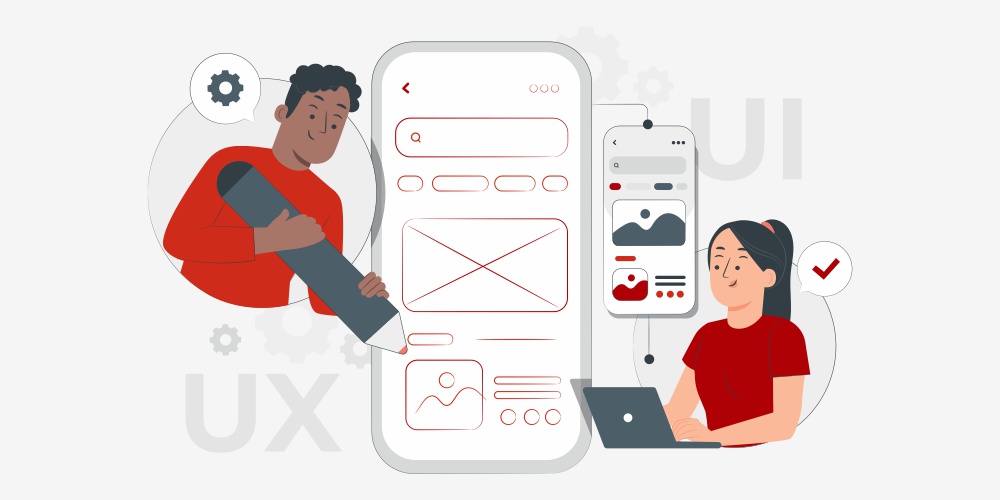
Frequently Asked Questions About Figma
Almost all questions that need to be answered about figma are listed in this section and each one is answered.
If your question is not among these questions and answers, please raise it in the comments section.
Figma is a cloud-based design tool widely used for UI/UX design, graphic design, prototyping, and collaborative team projects.
Its versatility allows designers to create complex layouts, interactive prototypes, and high-fidelity designs, all within a web browser.
Figma facilitates real-time collaboration, enabling teams to work together on the same files simultaneously, regardless of their physical location.
This tool is instrumental in streamlining the design process from ideation to final product, making it an essential utility for digital designers, product teams, and marketers alike.
Figma offers a robust free tier, providing individual designers and small teams access to its core features without cost.
This includes the ability to create unlimited files, collaborate in real-time, and utilize a vast array of design tools.
However, Figma also offers paid plans with additional features such as advanced security, unlimited version history, and team collaboration options.
These premium plans are designed to accommodate the needs of larger teams and organizations requiring more comprehensive functionality and control.
Figma’s popularity stems from its intuitive interface, real-time collaboration capabilities, and platform independence.
Being a web-based tool, it eliminates the need for powerful hardware and allows designers to access their work from anywhere, on any device with internet connectivity.
Its collaborative nature fosters a more integrated and efficient design process, enabling immediate feedback and iteration.
Moreover, Figma’s extensive plugin ecosystem and regular updates contribute to a continuously improving user experience, making it a go-to choice for designers worldwide.
Figma and Canva are both design tools, but they serve different purposes and audiences.
Canva is tailored towards non-designers, offering templates and a simple interface for creating social media graphics, presentations, and other marketing materials quickly.
Figma, on the other hand, is a more powerful and flexible tool designed for professional UI/UX design, prototyping, and collaborative projects.
While Canva emphasizes ease of use and template-driven design, Figma focuses on customization, collaboration, and the design process from concept to completion.
Designers might choose Figma over Adobe products for its seamless collaboration features, platform independence, and ease of use.
Unlike Adobe’s suite, which includes software like Photoshop and Illustrator, Figma is accessible directly from a web browser, facilitating real-time teamwork and feedback.
Figma also offers a free tier, making it accessible to individuals and small teams.
Its user interface is intuitive, lowering the learning curve for new users and enabling rapid prototyping and testing.
Adobe recognized Figma’s significant impact on the design world, particularly its innovative approach to collaboration and its cloud-based model.
By acquiring Figma, Adobe aimed to integrate Figma’s collaborative capabilities and web-based technology with its suite of design tools, thereby enhancing its offerings and staying ahead in the competitive design software market.
The acquisition was also a strategic move to consolidate Adobe’s position as a leader in the creative software industry, leveraging Figma’s technology and user base to expand its reach and capabilities.
The decision between learning Figma or Adobe XD depends on your specific needs, project requirements, and team collaboration preferences.
Figma is renowned for its real-time collaboration features and is web-based, making it easily accessible.
Adobe XD offers deep integration with other Adobe products and strong prototyping capabilities.
Both are powerful tools for UI/UX design, so consider your workflow, the tools your team uses, and the types of projects you’ll be working on before making a choice.
The time it takes to learn Figma can vary based on prior experience with design software and the depth of knowledge desired.
For those new to design tools, becoming comfortable with Figma’s basic features could take a few weeks of regular use.
However, mastering its more advanced capabilities, including prototyping and complex interaction design, may require a few months of dedicated learning and practice.
Figma’s intuitive interface and abundance of online resources help streamline the learning process.
Figma is widely regarded as user-friendly, especially for those with some background in graphic design or familiarity with other design tools.
Its intuitive interface and logical workflow make it accessible to beginners, while its comprehensive online resources, including tutorials and community forums, support the learning process.
New users can quickly grasp the basics of Figma, making it an attractive option for those looking to dive into digital design.
Figma is an independent company.
However, there was significant news about Adobe announcing its intention to acquire Figma.
This acquisition reflects the value and impact Figma has had on the design community and the broader technology landscape.
Figma’s free plan includes unlimited pages (or frames) within your projects, allowing for extensive exploration and design work without hitting a limit on how many individual screens or pages you can create.
Figma’s free tier is not limited by days; it’s available indefinitely.
This allows users to explore and use Figma’s core features without time constraints, making it an excellent option for learning and small-scale projects.
The fastest way to learn Figma for free is by utilizing the extensive range of tutorials and resources available online.
Figma’s website offers comprehensive guides.
Figma has redefined the landscape of digital design with its powerful features, collaborative environment, and accessibility.
Whether you’re a solo designer, part of a small startup, or working in a large team, Figma offers the tools and flexibility needed to bring your creative visions to life.
Despite some limitations, such as its reliance on internet connectivity, the pros far outweigh the cons, making Figma a valuable asset in the modern design toolkit.
By understanding its capabilities and learning how to leverage them effectively, designers can unlock new levels of creativity and efficiency in their work.

